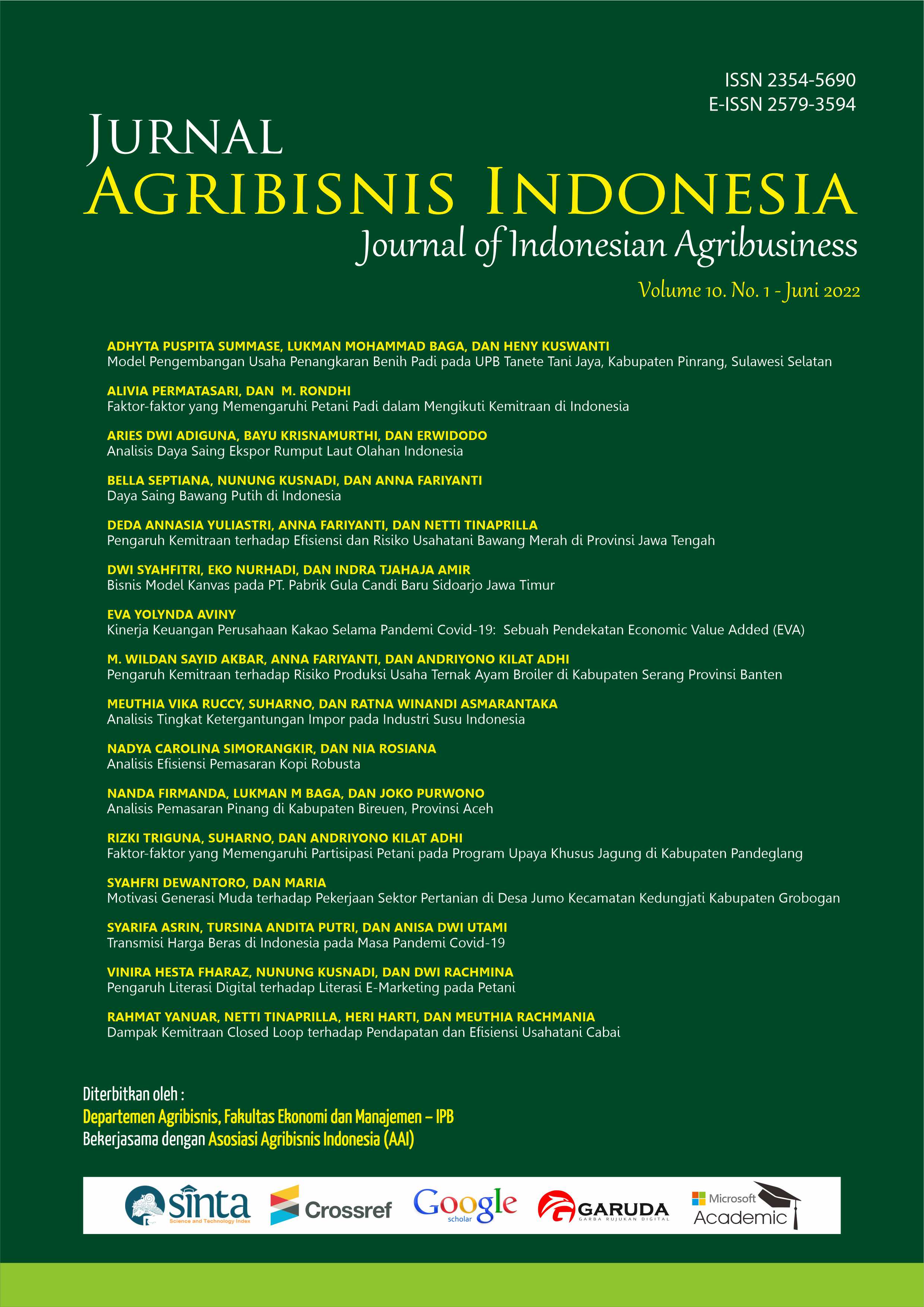Analisis Daya Saing Ekspor Rumput Laut Olahan Indonesia
Main Article Content
Abstract
Indonesia is one of the main exporters of seaweed in the world market. Seaweed traded consists of raw products and processed products. Processed seaweed products are in the form of gelatin with HS code 130231 and carrageenan with HS code 130239. The high demand and value of processed seaweed products is an opportunity for Indonesia. The total world demand for agar in 2018 was 275,188,000. US$ increased 4.9 percent from the previous year, while carrageenan in 2018 had total world demand amounted to 1,131,820,000 US$, an increase of 8.4 percent from the previous year (ITC, 2019). This research aimed to analyze the competitiveness of processed seaweed and determine policies to increase Indonesian processed seaweed exports in the world market. The data in this study used secondary data. The competitiveness of processed Indonesian seaweed products is measured using Revealed Comparative Analysis (RCA) and Export Product Dynamic (EPD). The results of the analysis showed that processed Indonesian seaweed in the form of carrageenan and agar has comparative competitiveness in the world market. The position of competitiveness in the main destination countries with rising star status has strong competitiveness, but the increasing demand for processed seaweed in the world has caused Indonesia to lose the opportunity to optimize its profits. Indonesia needs to increase the quantity of processed seaweed exports in the form of carrageenan and agar by encouraging domestic investment to develop the seaweed processing industry sector.
Downloads
Article Details

This work is licensed under a Creative Commons Attribution 4.0 International License.
Jurnal Agribisnis Indonesia (JAI) is an Open Access Journal. The authors who publish the manuscript in this journal agree to the following terms:
Creative Commons License
JAI is licensed under a Creative Commons Attribution 4.0 International License. This permits anyone to copy, redistribute, remix, transmit, and adapt the work provided the original work and source are appropriately cited.
This means:
(1) Under the CC-BY license, authors retain ownership of the copyright for their article, but authors grant others permission to use the content of publications in Jurnal Agribisnis Indonesia in whole or in part provided that the original work is properly cited. Users (redistributors) of JAI are required to cite the original source, including the author's name, JAI as the initial source of publication, year of publication, volume number, issue, and Digital Object Identifier (DOI); (2) Authors grant JAI the right of first publication. Although authors remain the copyright owner.
References
Balassa B. (1965). Trade Liberalization and Revealed Comparative Advantage. Manchester School of Economics and Statistic, 33, 99-124. https://doi.org/10.1111/j.1467-9957.1965.tb00050.x
Damalia, E., dan Soesilowati, E. (2016). The Strategy to Improve the Competitiveness of Indonesian Seaweeds in Global Market. Jurnal Ekonomi Pembangunan, 17(2), 193-204. 10.23917/jep.v17i2.2392
Esterhuizen D. 2006. Measuring and Analyzing Competitiveness in the Agribusiness Sector. SA: University of Pretoria.
[FAO]. Food and Agriculture Organization of The United Nations. 2018. The global status of seaweed production, trade and utilization. Globefish Research Programme. Volume 124. Rome.
International Trade Center. 2019. List of exporters for the selected product. http:///trademap.org. [9 November 2019].
Kementerian Kelautan dan Perikanan. 2019. Rumput laut dan pemanfaatannya. www.kkp.go.id. [November 2019].
Kementerian Kelautan dan Perikanan. 2019. Keberlanjutan dan kualitas produksi dalam menunjang masa depan rumput laut indonesia. www.kkp.go.id. [November 2019].
Laursen K. (2015). Revealed Comparative Advantage and The Alternatives as Measures of International Specialization. Eurasian Bus. Rev, 5(1), 99–115. 10.1007/s40821-015-0017-1
Maximo, AR., Pedro, BB., dan Virgilia, TS. (2018). Maximizing Opportunities in Seaweeds Farming. Southeast Asian Fisheries Development Center, 6(1), 26- 33.
Quilloy, CB., dan Monis, DLL. (2013). Export Competitiveness of Philippine Seaweed before and During the Implementation of Agriculture and Fisheries Modernization Act (AFMA). AGRIS, 15(2), 198-199.
Rajagukguk., dan Majus, M. 2009. Analisis Daya Saing Rumput Laut Indonesia di Pasar Internasional. [skripsi]. Bogor: Institut Pertanian Bogor.
Merdekawati, W., dan Susanto, AB. (2009). Kandungan dan Komposisi Pigmen Rumput Laut serta Potensinya untuk Kesehatan. Squalen. 4(2): 41-47. https://doi.org/10.15578/squalen.v4i2.147.
Pramono, YE., Fathoni, M., Himelda., Wiro, PH., Hanifah, T., Robiyanto, S., Aida, N., dan Marpuang, H. 2014. Pedoman Ekspor Perikanan ke Negara Mitra. Jakarta: Direktorat Pemasaran Luar Negeri.
[RI] Presiden Republik Indonesia. 2019. Peraturan Presiden Nomor 33 Tahun 2019 tentang Peta Panduan (Road Map Pengembangan Industri Rumput Laut Nasional Tahun 2018-2021. Jakarta: Pemerintah Pusat.
Satya, NR., Ridhwan, MM., Wicaksono, G., Nurliana, L., Bary, P., dan Suryani, FT. 2015. Analisis Daya Saing dan Strategi Industri Nasional di Era Masyarakat Ekonomi ASEAN dan Perdagangan Bebas. Jakarta: Working Paper Bank Indonesia
Wibowo, Y., Ma'ruf, MS., Fauzi, AM., dan Adrianto, L. (2011). Strategi Pengembangan Klaster Industri Rumput Laut yang Berkelanjutan. Agritek. 12(1): 85-98.

